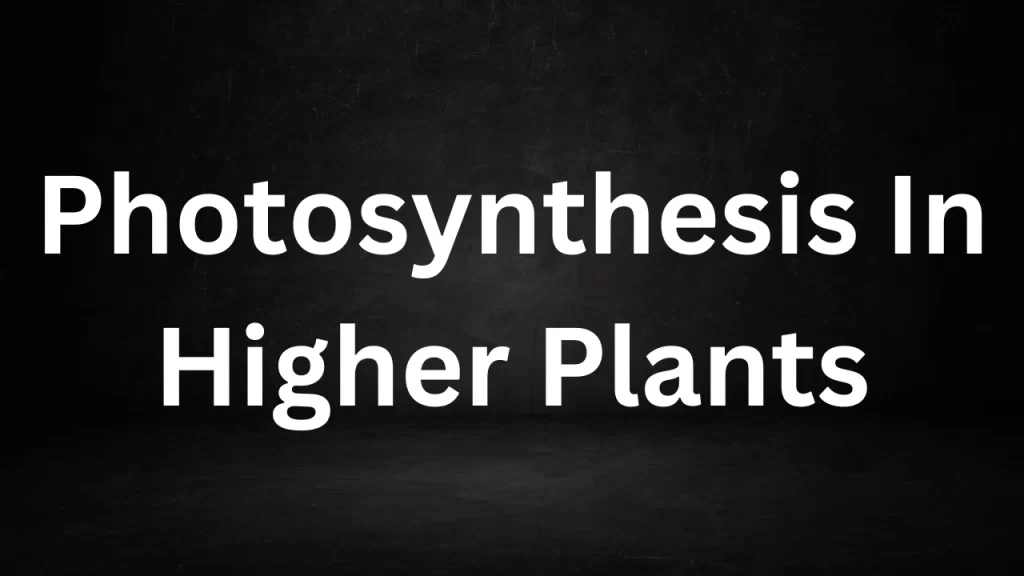Photosynthesis In Higher Plants
Photosynthesis In Higher Plants: Photosynthesis is a complex and vital process that sustains life on Earth by converting sunlight into energy-rich molecules.
In higher plants, this phenomenon is a cornerstone of their biology, enabling them to synthesize their own food and release oxygen into the atmosphere.
In this article, we will explore the remarkable journey of photosynthesis in higher plants, from its fundamental principles to its ecological significance.

Photosynthesis In Higher Plants
The Photosynthesis Equation
The chemical equation that represents photosynthesis is as follows:
6 CO2 + 6 H2O + light energy → C6H12O6 (glucose) + 6 O2
This equation illustrates that photosynthesis requires carbon dioxide and water in the presence of light energy to produce glucose and release oxygen as a byproduct.
Key Steps of Photosynthesis
Photosynthesis can be divided into two main stages:
1. Light-Dependent Reactions:
These reactions occur in the thylakoid membranes of chloroplasts and depend on the absorption of light by pigments, primarily chlorophyll. The key steps include:
Light Absorption: Chlorophyll molecules absorb sunlight and convert it into chemical energy.
- Water Splitting: Water molecules are split (photolysis), releasing oxygen, protons (H+ ions), and electrons.
- ATP and NADPH Formation: The energy from sunlight is used to generate ATP (adenosine triphosphate) and NADPH (nicotinamide adenine dinucleotide phosphate), which are energy-rich molecules.
2. Light-Independent Reactions (Calvin Cycle):
The Calvin Cycle, which occurs in the stroma of chloroplasts, is the second stage of photosynthesis. It utilizes the ATP and NADPH generated in the light-dependent reactions to fix carbon dioxide and synthesize glucose. The key steps include:
- Carbon Fixation: Carbon dioxide from the atmosphere is captured and converted into a three-carbon compound called 3-phosphoglycerate (3-PGA).
- Reduction: ATP and NADPH provide energy and electrons to convert 3-PGA into glyceraldehyde-3-phosphate (G3P), a sugar molecule.
- Regeneration of RuBP: Some G3P molecules are used to regenerate ribulose-1,5-bisphosphate (RuBP), a critical molecule in the Calvin Cycle.
- Glucose Synthesis: G3P molecules are further processed to form glucose and other organic molecules.
Significance of Photosynthesis in Higher Plants
- Food Production: Photosynthesis is the foundation of the food chain. Higher plants produce glucose and other organic compounds, which serve as primary sources of energy and nutrients for animals and humans.
- Oxygen Release: Photosynthesis generates oxygen as a byproduct, essential for respiration in all living organisms, including humans.
- Carbon Dioxide Absorption: Plants absorb carbon dioxide during photosynthesis, helping to mitigate the greenhouse effect and reduce global warming.
- Energy Storage: Glucose produced during photosynthesis is used by plants for energy and growth and can also be stored as starch for future use.
- Ecological Impact: Photosynthesis shapes ecosystems, providing resources for herbivores and carnivores alike, and influencing the diversity and distribution of life on Earth.
- Human Agriculture: Understanding photosynthesis has enabled humans to optimize crop production and develop agricultural practices to feed the growing global population.
- Scientific Research: Photosynthesis continues to be a subject of intense scientific study, with ongoing research aimed at improving crop yields, harnessing renewable energy, and understanding fundamental biological processes.
Photosynthesis in higher plants is a remarkable and intricate process that fuels life on our planet. It serves as a testament to the intricate balance of nature, where the simple act of capturing sunlight sustains the complexity of the Earth’s ecosystems and all living organisms within them.
Read More
- Motion In A Plane
- Basic Properties Electrical Charge
- Anatomy Of Flowering Plants
- Elastic Behaviour Of Materials
- Molecular Weight Of Oxalic Acid
Frequently Asked Questions (FAQs) Photosynthesis In Higher Plants
1. What is Photosynthesis?
Photosynthesis is the process by which green plants, algae, and certain bacteria convert sunlight, carbon dioxide (CO2), and water (H2O) into glucose (a form of sugar) and oxygen (O2). This energy-conversion process takes place in specialized cellular structures called chloroplasts, mainly in the green parts of plants, such as leaves.
2. Where does photosynthesis primarily take place in higher plants?
Photosynthesis mainly occurs in the chloroplasts of plant cells, particularly in the green parts of the plant, such as leaves.
3. What is the significance of photosynthesis?
Photosynthesis is essential for life on Earth. It provides food for plants and serves as the foundation of the food chain, releasing oxygen into the atmosphere and absorbing carbon dioxide. It also supports ecosystems and human agriculture.
4. What is the chemical equation for photosynthesis in higher plants?
The chemical equation for photosynthesis is: 6 CO2 + 6 H2O + light energy → C6H12O6 (glucose) + 6 O2. This equation represents the conversion of carbon dioxide and water into glucose and oxygen using light energy.
5. What are the two main stages of photosynthesis?
Photosynthesis consists of two main stages: the light-dependent reactions, which occur in the thylakoid membranes of chloroplasts, and the light-independent reactions (Calvin Cycle), which take place in the stroma of chloroplasts.